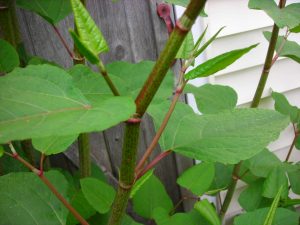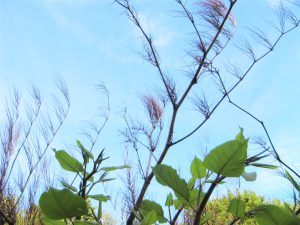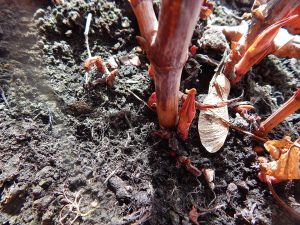Guide by Stuart Snape, Head of Japanese Knotweed Claims, Graham Coffey & Co. Solicitors
Japanese knotweed is a troublesome and invasive weed that can cause significant damage to properties and their foundations. It’s also incredibly difficult to get rid of due to the laws and regulations surrounding its disposal.
Here, Stuart Snape, Head of Japanese Knotweed claims at Graham Coffey & Co. Solicitors, talks us through the key things you should look out for when trying to spot it, as well as the best ways to ensure you remove it from your property effectively.
What does Japanese knotweed look like?
Japanese knotweed has a distinctive appearance. If your garden contains knotweed, in the springtime you will notice red/purple shoots appearing with quite a wide stalk, which then lengthen into spears on top of pink buds.
The stems start to form into those similar to bamboo, before developing heart-shaped green leaves. In summer, these leaves will begin to flower with creamy-white fauna clusters. Often, the stem will grow in a zig-zag pattern and start to show purple and red speckles. The root, also known as the rhizome, can be anything from a few mm to 20cm in width. The root is usually a dark brown colour with a bright orange inner centre, which will snap easily when put under pressure.
When is the best time to spot Japanese knotweed?
In short, you should try to spot the plant as soon as possible. Definitely lookout for signs of disturbance caused by Japanese knotweed upon your first viewing if you can.
It’s recommended that you look for Japanese knotweed during the summer months and early autumn, as this is when the plant is most prominent. Otherwise, the plant can die back down during winter, which makes it harder to detect.
The plant can grow as much as 2cm per day during its active months, making it a difficult one to keep control of, so spotting it early on can help to minimise the damage and destruction it can cause.
How does Japanese knotweed spread?
Japanese knotweed is a plant that thrives much faster than typical ones. Throughout summer, the plant can grow excessively and can be spread when fly-tipped or transported through waterways where heavy rain and flooding is likely to occur. It’s illegal to fly-tip Japanese knotweed and it must be removed correctly, otherwise, you could be subject to a fine.
Japanese knotweed often clusters around riverbanks, roadsides and building sites where the plant hasn’t been thoroughly searched for or correctly removed. It can also be found around railways and their bankings.
Wet weather conditions can also cause the plant to spread much more rapidly.
How can I find out if Japanese knotweed has been previously discovered on the property?
If you are looking to buy a property and you want to know whether it has been affected by knotweed, ask the current/previous owner to provide you with this information in the form of a TA6 Property form. This form is also known as ‘the Law Society Property Information Form’ and is completed by the seller to provide potential buyers with detailed information regarding the property.
We would recommend that you always instruct your solicitor to ask this specific question in addition to the TA6 Property Form.
If they don’t have this information available, you can have a Japanese knotweed survey and management plan report professionally conducted. This will highlight any issues and also the costs of rectifying them. However, it’s recommended that no sale goes ahead without the TA6 form.
Do not rely on a valuation survey alone. They are often for the benefit of the lender and are focussed on the property value. Make sure any surveyor is instructed to specifically deal with the issue of Japanese knotweed and insist that any report includes a review, not only of the property being purchased, but the neighbouring land around the boundary.
Why is it important to find this out first?
It’s important to know whether a property has been affected by Japanese knotweed before you buy, as this means that the responsibilities of eradication will still lie with the landowner.
Most banks and lenders won’t lend money on a property that has been affected by Japanese knotweed unless there are certain plans in place, such as a fully paid-up treatment plan to remove the plant, or insurance provided by removal companies to ensure the plant won’t come back.
It’s important to discuss the specifics of these plans with your lender, as each one may require something different in order to provide you with the funds needed to buy if you still wish to proceed with the purchase of the affected property.
What can happen if Japanese knotweed is left on a property?
If Japanese knotweed isn’t recognised, or has been left or treated incorrectly, it can come back with a vengeance and cause structural damage to the property and the land it is built on.
The unruly plant is able to damage buildings that have existing areas of weakness, such as cracks in the exterior walls or patios. This causes the foundations of the building to become even weaker, allowing the knotweed to grow through the walls and drainage systems, sometimes making its way into interior walls. Once this has happened, it’s incredibly difficult and costly to get rid of as it often requires removing the entire wall or resetting the foundations.
How can you minimise costs when dealing with Japanese knotweed?
Removing Japanese knotweed from a property can be a costly and time-consuming task due to the need for a professional to excavate it correctly. If the plant isn’t correctly treated, or steps are skipped over and rushed, the plant could eventually grow back and cause even more damage than before.
It’s important that you do not chop down or mow Japanese knotweed, as the pieces of rhizome will cause it to spread further. The plant also cannot be killed with the use of a mechanical chipper – this will just further spread the plant and cause it to regrow in other areas if the chipped material is distributed.
It might seem obvious, but don’t add the remains of the Japanese knotweed to your compost. This would allow the plant to regrow and also cause damage to your existing flower beds and garden parameters.
As soon as you realise that your property is affected by the plant, report it straight away and contact a professional Japanese knotweed removal company to begin planning the best way forward in terms of eradication. Do not allow the plant to become established, as the issue will only grow. You may want to seek advice from a solicitor if you are in the process of selling your property, or if you have recently bought it, as you may be entitled to some compensation to help with the cleanup process.
What types of removal processes are available?
It’s recommended that you only seek the help of a professional removal specialist, as you can receive fines if you dispose of Japanese knotweed incorrectly.
Treatment is a lengthy process that needs to be repeated several times per year in order to maintain long-term control. There are three types of Japanese knotweed control that can be performed:
Chemical control: This can be a risky option, especially if the plant grows near water, as it could contaminate supplies and cause danger to those living nearby, both human and animal. You must seek consent from the Environment Agency to use these herbicides if the plant is located near waterways.
If consent is granted, the herbicide is normally sprayed onto the plant or applied inside the hollow stems immediately after the plant is cut down. This is a costly option and can take a long time, making it time-consuming also.
Natural control: This uses living organisms to control the plant. However, the natural enemies of Japanese knotweed such as the psyllid bug are not typically found in the UK, meaning that this isn’t always an easy option. A wild Japanese insect was released to help tackle the amount of Japanese knotweed on UK soil, but this is simply a form of control, not eradication.
Physical removal: This is a short-term solution that helps stunt the spread of the plant but does not fully eradicate it. The plant will continue to grow when the cutting stops, so it’s also a time-consuming process that will never fully remove the plant from the property. The waste also needs to be disposed of accordingly in relation to the Environmental Protection Act 1990.
Ultimately, Japanese knotweed can cause a significant amount of damage and distress, but if you follow these steps and ensure you spot the weed before it has a chance to spread, you can ensure your garden and property are protected.






